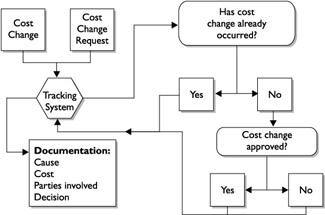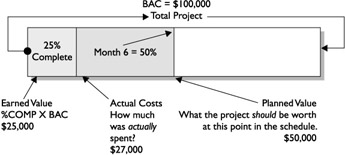Implementing Cost Control
|
| < Day Day Up > |
|
Cost control focuses on the ability of costs to change and on the ways of allowing or preventing cost change from happening. When a change does occur, the project manager must document the change and the reason why the change has occurred and, if necessary, create a variance report. Cost control is concerned with understanding why the cost variances, both good and bad, have occurred. The “why” behind the variances allows the project manager to make appropriate decisions on future project actions.
Ignoring the project cost variances may cause the project to suffer from budget shortages, additional risks, or scheduling problems. When cost variances happen they must be examined, recorded, and investigated. Cost control allows the project manager to confront the problem, find a solution, and then act accordingly. Specifically, cost control focuses on these activities:
-
Controlling causes of change to ensure the changes are actually needed
-
Controlling and documenting changes to the cost baseline as they happen
-
Controlling changes in the project and their influence on cost
-
Performing cost monitoring to recognize and understand cost variances
-
Recording appropriate cost changes in the cost baseline
-
Preventing unauthorized changes to the cost baseline
-
Communicating the cost changes to the proper stakeholders
-
Working to bring and maintain costs within an acceptable range
Considering Cost Control Inputs
To implement cost control, the project manager must rely on several documents and processes:
-
Cost baseline The cost baseline is the expected cost the project will incur. This time-phased budget reflects the amount that will be spent throughout the project. Recall that the cost baseline is a tool used to measure project performance.
-
Performance reports These reports focus on project cost performance, project scope, and planned performance versus actual performance. The reports may vary according to stakeholder needs. We’ll discuss performance reporting in detail in Chapter 10.
-
Change requests When changes to the project scope are requested, an analysis of the associated costs to complete the proposed change is required. In some instances, such as removing a portion of the project deliverable, a change request may reduce the project cost.
-
Cost management plan The cost management plan dictates how cost variances will be managed.
Creating a Cost Change Control System
Sometimes a project manager must add, or remove, costs from a project. The Cost Change Control System is part of the Integrated Change Control System and documents the procedures to request, approve, and incorporate changes to project costs.
When a cost change enters the system, there is appropriate paperwork, a tracking system, and procedures the project manager must follow to obtain approval on the proposed change. Figure 7-4 demonstrates a typical workflow for cost change approval. If a change gets approved, the cost baseline is updated to reflect the approved changes. If a request gets denied, the denial must be documented for future potential reference.

Figure 7-4: A Cost Change Control System tracks and documents cost change issues.
Measuring Project Performance
Earned Value Management (EVM) is the process of measuring performance of project work against a plan to identify variances. It can also be useful in predicting future variances and the final costs at completion. It is a system of mathematical formulas that compares work performed against work planned and measures the actual cost of the work performed. EVM is an important part of cost control as it allows a project manager to predict future variances from the expenses to date within the project.
EVM, in regard to cost management, is concerned with the relationships between three formulas that reflect project performance. Figure 7-5 demonstrates the relation between these EVM values:

Figure 7-5: Earned value management measures project performance.
-
Planned Value (PV) Planned Value is the work scheduled and the authorized budget to accomplish that work. For example, if a project has a budget of $100,000 and month six represents 50 percent of the project work, the PV for month six is $50,000. Planned Value used to be known as the Budget Cost of Work Schedule (BCWS), and you may see this term on the PMP Exam.
-
Earned Value (EV) Earned Value is the physical work completed to date and the authorized budget for that work. For example, if a project has a budget of $100,000 and the work completed to date represents 25 percent of the entire project work, its EV is $25,000. Earned Value used to be known as the Budgeted Cost of Work Performed (BCWP).
-
Actual Cost (AC) Actual Cost is the actual amount of monies the project has required to date. For example, if a project has a budget of $100,000 and $35,000 has been spent on the project to date, the AC of the project would be $35,000. Actual Cost used to be known as Actual Cost of Work Performed (ACWP).
These three values are key information about the worth of the project to date (EV), the cost of the project work to date (AC), and the planned value of the work to date (PV). These values will be revisited later in this chapter and in Chapter 10.
Additional Planning
Planning is an iterative process. Throughout the project there will be demands for additional planning—and an output of cost control is one of those demands. Consider a project that must complete by a given date and that also has a set budget. The balance between the schedule and the cost must be kept. The project manager can’t assign a large crew to complete the project work if the budget won’t allow it. The project manager must, through planning, get as creative as possible to figure out an approach to accomplish the project without exceeding the budget.
The balance between cost and schedule is an ongoing battle. While it’s usually easier to get more time than money, this isn’t always the case. Consider deadlines that can’t move, or the company may face fines and penalties, or a deadline that centers on a tradeshow, an expo, or the start of the school year.
Using Computers
It’s hard to imagine a project, especially larger projects, moving forward without the use of computers. Project managers can rely on project management software and spreadsheet programs to assist them in calculating actual costs, earned value, and planned value.
| On the Job | It’s not hard to create a spreadsheet with the appropriate earned value formulas. Once the spreadsheet has been created, you can save it as a template and use it on multiple projects. If you want, and your software allows it, you can tie in multiple earned value spreadsheets to a master file to track all of your projects at a glance. |
|
| < Day Day Up > |
|
EAN: 2147483647
Pages: 209